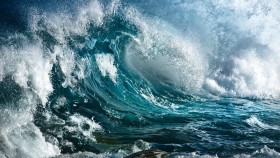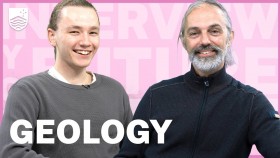Mallory Young
Ocean waves could point way to “hot rock” alternative energy reserves
The jittering of the Earth’s crust as ocean waves break on the shore could shine the path to reserves of geothermal energy, an alternative power source promising to help drive Australia’s switch to a low carbon economy.
Australian National University scientist Mallory Young, of the Research School of Earth Sciences, is investigating the use of these vibrations as a way to probe the Earth’s outer layer.
The method has the potential to complement conventional geophysical survey techniques in the search for geothermal energy reserves – rocks heated by the decay of naturally occurring radioactive elements.
Scientists have long used earthquake waves to study the inner Earth. The method is based on the change in the speed of the waves as they pass through media of differing densities.
Waves reverberating through the crust when ocean waves pound the shore can work as well, says Young, a PhD candidate.
They would extend the area currently mapped by earthquake seismology, she says.
But until recently, these tiny vibrations have been the bane of seismologists, dismissed as background noise as they confuse the signals from earthquakes.
"It was once thought that the noise was totally meaningless and not worth anything," she says. "But it turns out you can get information from it. If you manipulate it mathematically, you can learn about the structure of the Earth.
"Usually, too much noise makes data worthless. But I use the stuff everyone else throws away."
She says existing maps of the interior of the crust are limited.
"Our current maps of the Earth are limited by the location of earthquakes, but earthquakes only happen in certain areas – along continental and oceanic plate boundaries, for example" she says.
"My goal is to eliminate the need for earthquakes to image the Earth."
Conventional seismology centres on data from individual seismometers to investigate the structure of the Earth between the earthquake epicentre and the instrument.
Scientists use the data to calculate the Green’s function, which reveals properties, such as the density and thickness of layers through which the earthquake waves propagated.
Using the new method, Young correlates data logged at the same time from two seismometers at different locations to calculate the Green’s function for the section of crust between the two stations.
She says industry is interested in the technique to locate areas where geothermal energy could be tapped to generate electricity. Water would be injected into the hot rocks, with the heat transferred to the Earth’s surface, where the energy would be harnessed to drive turbines.
Young says the slowing of the crustal waves is a tell-tale sign of regions of anomalously high crustal temperatures.
Young, who has a Bachelor’s degree in physics from Hendrix College in Arkansas, was drawn to the RSES project because it offered the chance to develop a revolutionary technique.
"The method has only been around for a few years, and there’s still much room for improvement" she says.













